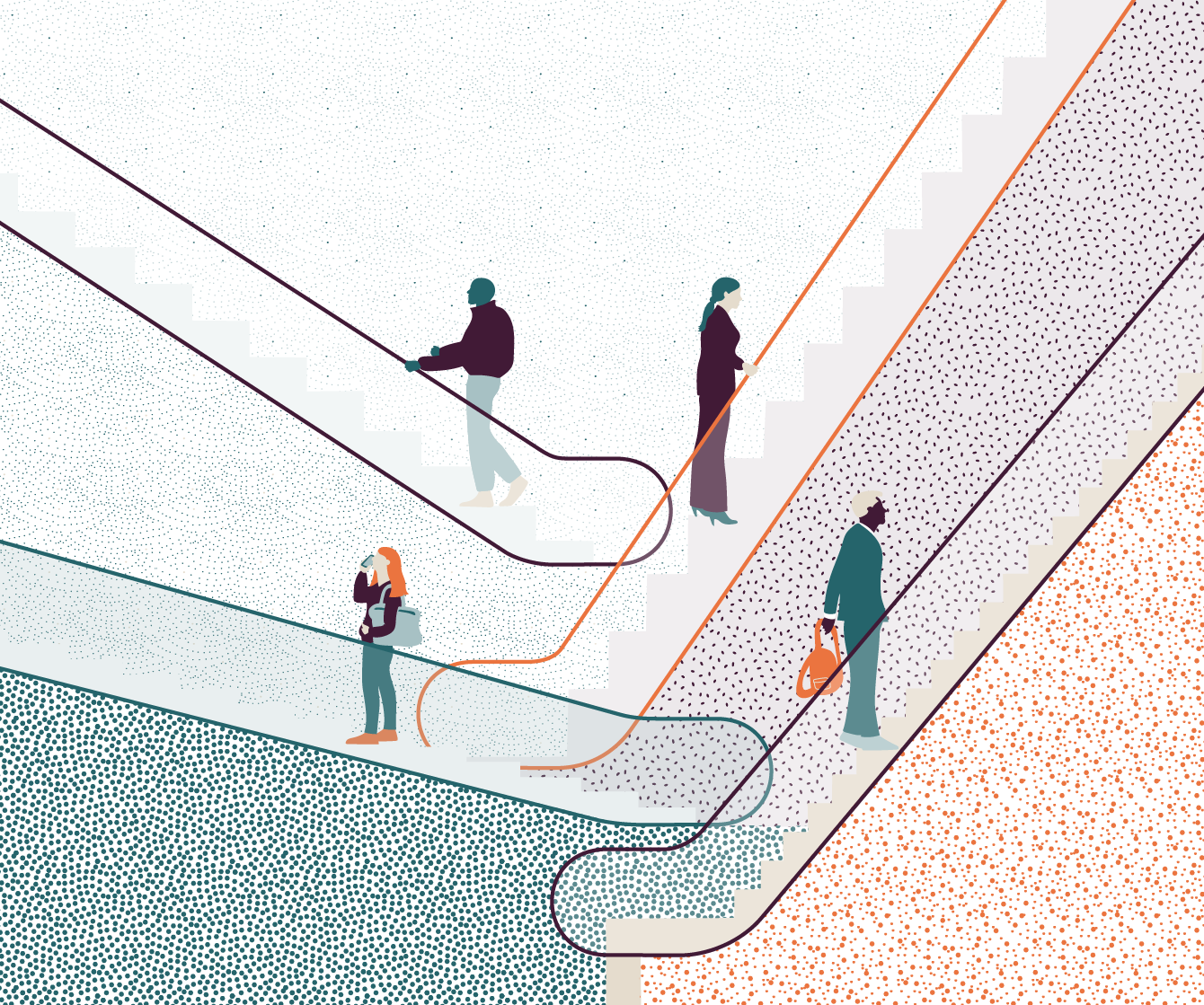Knowledge Base
Inequality
The rising gap between the rich and the poor has become a threat to social cohesion in most rich countries. To reverse the trend it will be crucial to better understand the importance of different drivers of income and wealth inequality.

The Challenge
Inequality in advanced countries, such as Germany, has reached levels of 100 years ago.
Berlin economist Charlotte Bartels has estimated that the share of total income of the top 10% of households has risen from less than 30% in the late 1960s to more than 40% today (Bartels, 2019).
Germany has thus reached a level of income inequality comparable to the level of 100 years ago. This can also be observed in the evolution of the Gini-coefficient, a measure of overall inequality across the population, which has risen from 0.25 in 1991 to 0.3 in 2016 (Spannagel and Molitor, 2019). Even though Germany has benefitted from ten years of prolonged economic growth with real incomes rising for a majority of the population, income inequality has not decreased since the start of the latest economic growth period in 2009 (Grabka et al., 2019).
Wealth inequality is more difficult to measure since a significant share of wealth of the richest households is held in tax havens, and important assets (bonds) are often measured at their face value. Recent research that is attempting to overcome these difficulties has found that wealth inequality has surged over the last four decades. In the US, the top 0.1% of households, have seen their share of total wealth increase from 7% in 1978 to 22% in 2012. Today’s wealth concentration is thereby almost as high as in 1929, the year when the stock market crash on Wall Street put an abrupt end to the Roaring Twenties and marked the beginning of the Great Depression (Saez and Zucman, 2016). Germany seems to be no exception. After a reduction of wealth concentration between World War I and the 1950s, wealth inequality has been increasing since the 1990s (Albers et al., 2020). Today, Germany’s wealth concentration seems to be staggeringly high, with the top 1% of wealthiest households owning 24% of total net national wealth. With 61 thousand Euros, Germany’s median household net wealth is among the lowest in the European Union, just about the same level as those of Poland and Greece (IMF, 2019).
After decades of rising inequality the gap between the rich and the poor has apparently reached highly critical levels for many societies. According to the Forsa poll commissioned by the Forum New Economy about 80% of Germans agreed that inequality has reached levels such that it seriously endangers social cohesion. Only a third said that they think that the very rich generally merit their wealth. Both results seem to reflect a deep crisis of credibility in the economic and political system as it works.
What went wrong
It is often repeated that inequality is just a transitory phenomenon and is necessary for dynamism and economic growth.
During the three decades when the strongly market-driven paradigm was adhered to, inequality was praised as an incentive to work and develop new skills. Most mainstream economists considered inequality a necessary by-product of a functioning market economy in which individuals are free to make decisions about their education, work and risk-taking. In fact, inequality was largely considered a useful device for providing incentives to take risks and work hard, thereby generating economic benefits for all. Numerous previous studies found that inequality had no significant negative impact on economic growth or on other economic aggregates (Fratzscher, 2018).

Because part of the orthodox literature acknowledged that the market economy may not always work perfectly, it also considers a strong social welfare state to be a useful tool for compensating losers and ensuring social peace. When income inequality started rising in the 1980s and 1990s in many Western economies, academics and policymakers could no longer ignore the trend.
The initial reaction was to blame globalization as the main culprit and insist that national policymakers could do little about it. Some authors argued that because markets would ensure that workers were remunerated according to their skills, income inequality just was an unavoidable transitory phenomenon due for example to technological change. For adherents to this idea, income inequality is due to the information and communications technology revolution, which raised the demand for workers with the skills required to use new technologies such as computers.
Overall, according to the strongly market-based paradigm, inequality was also considered as necessary because it thus provides an incentive for people to invest in their own (higher) education; the increasing number of firms that adopted computers and employed qualified labor provided support for the proponents of this model of skills-biased technological change (Juhn et al., 1993; Katz, 1999).
Yet, the emphasis on the imperatives of globalization or skills-biased technological change provided a political argument for the reduction of the top income tax rate. This reduction was then put in place under Ronald Reagan in the US, Margaret Thatcher in the UK and, later, in other countries like Germany. In Germany, the top income tax rate (Spitzensteuersatz) was lowered from 51% in 2000 to 42%, a decision taken by a social-democrat government in the heyday of supply-side economics in the country.
The proponents of market-liberalism maintained that the incentives provided by initially rising inequality would lead to a much more dynamic economy which then would allow those at the bottom of the income scale to catch-up. Tax cuts for the rich would thus “trickle down” and be the most effective way to increase prosperity, it was said. During these decades, large parts of the economic profession has indeed framed inequality as a positive factor that drives economic dynamism and growth.
Since then all of these assumptions seem to have been seriously challenged by reality. The prediction made by Kuznets (1955) that modern inequality will soon disappear as the new technology spreads has yet to come to pass. Instead, recent research has revealed that the measures of inequality describe a U-shaped pattern, with inequality rising almost uninterruptedly in advanced countries from its low point in the 1970s (Piketty, 2014).
While it is increasingly evident that both income and wealth inequality have been rising, the drivers of inequality and remedies are yet to be identified adequately. Some authors have argued that the key driver of the rapid increase in wealth at the top is the explosion of rising incomes at the top. As rising top incomes generate higher rates of savings, this drives wealth concentration up (Saez and Zucman, 2016). At the same time, labor bargaining power has decreased with a decline in the rate of unionization, and the wage share of the bottom 90% has stagnated or even fallen in many advanced countries over the past decades. Even real wages have stagnated or even fallen in advanced countries over the past decades. In 2019, real wages in the US for less educated workers were around 9% below their peak in 1973 (Blanchflower, 2019).
There is now increasing evidence suggesting that a main explanation to rising wealth inequality lies in the characteristics and dynamics of asset prices. Research on the US by Moritz Schularick and his colleagues has determined the following: Stock market booms, for example, primarily boost the wealth of households at the top of the US wealth distribution, while housing booms lead to substantial wealth gains for the American middle class (Kuhn et al., 2019). In the US, the sharp rise in wealth inequality after the Global Financial Crisis can thereby be explained by the collapse and slow recovery of the housing prices, while stock prices have literally exploded. For Germany, Moritz Schularick and his colleagues found that the housing boom since 2011 has primarily benefitted the wealthiest households. More than half of the capital gains of the price increase of housing since 2011 went to the top 10% (Baldenius, 2019).
The notorious trickle-down effect is nowhere to be seen and recent research has found that the effect of tax cuts for the top 10% on employment growth is small.
A clear positive relationship between tax cuts and employment growth is verifiable only when taxes are cut for lower-income groups (Zidar, 2019). Yet, tax cuts have disproportionately favored the ultra-rich, who have seen their taxes collapse to levels last seen in the 1920s. Indeed, Emmanuel Saez and Gabriel Zucman have estimated that today the 400 wealthiest families in the US pay a lower tax rate than the middle class (Saez and Zucman, 2019).
One reason why “trickle down” is not working simply seems to be that people save a larger proportion of their income if they are at the top of the income distribution (Dynan et al., 2004). This “excess saving,” however, creates extra leverage and funds that are channeled into the financial system. Indeed, inequality via its effect on the supply of credit has been highlighted as a key factor in the runup to the Global Financial Crisis (Kumhof et al, 2015; Mian and Sufi, 2018).
A new strand of the literature is now investigating possible mechanisms regarding how inequality could cause financial instability and reduce economic growth. As inequality increased in the run-up to the Global Financial Crisis, excess savings of the rich were channeled towards the non-rich households, which increased their consumption despite stagnating real incomes in order to maintain their status (Bertrand and Morse, 2016). This highly leveraged economy was masked by the increase in housing prices, which increased the net wealth for much of the middle class (Mian and Sufi, 2011; Kuhn et al, 2019; Albers et al., 2019). However, when the bubble burst in 2008 the same leveraged households cut back on their consumption because they saw the value of their houses plummet (Mian et al., 2013). Furthermore, this caused their debt relative to their net worth to increase, and it has been argued that this “debt overhang” and the process of deleveraging contributed to an extended period of suppressed consumption (Dynan, 2012).
Another strand has begun to document other negative effects of inequality. Apart from its contribution to financial instability, some researchers are investigating whether inequality could have a negative impact on economic growth (Cingano, 2014; Ostry et al., 2014). Inequality may harm growth because it reduces the health of the poor and restricts the accumulation of human capital (Perotti, 1996; Galor and Moav, 2004; Aghion, Caroli, and Garcia-Penalosa, 1999); inequality creates political and economic instability that reduces investment (Alesina and Perotti, 1996); and inequality reduces the potential to adjust to shocks and sustain growth as society’s consensus deteriorates (Rodrik, 1999; Ostry et al., 2014). Moreover, recent research has shown that economic distress was a decisive factor in the recent surge of right-wing populism in Britain, France and the US (Becker et al, 2017; Ferguson et al., 2018).
A new consensus is emerging that our economic system inherently tends to produce inequality.
Piketty (2014) famously stated that the return on capital is larger than the growth rate of the economy; however, little is understood about the drivers of this process. Is it increasing income inequality and the rise of the super-manager who is responsible for the overall increase in wealth and income inequality as Piketty (2014) has argued? If so, what are the contributions of individual income sources such as rents from housing? Or is inequality largely driven by wealth effects as occur during asset price booms? If so, what is the role of the real estate sector? Disentangling these factors becomes even more difficult because changes in housing expenditures have dramatically exacerbated the trend of income inequality, as has been shown for Germany (Dustmann et al., 2018). To combat inequality, future research will have to delve deeper into these dynamics and investigate the relative importance of the various drivers of inequality.
New Economy in Progress
Inequality is a political choice, produces discontent and can even lead to financial instability.
Until recently, economists have not paid much attention to inequality. The mainstream view was most notoriously stated by Robert Lucas (2004):
“Of the tendencies that are harmful to sound economics, the most seductive, and in my opinion the most poisonous, is to focus on questions of distribution.”
But with inequality reaching seemingly unacceptable levels and the negative effects of inequality becoming more visible, this view seems to have been misguided. Rather, it seems that as long as capitalists used their surplus income not to consume but to invest, the social contract held (Milanovic, 2019). Today’s developments, however, suggest that the social contract no longer holds.
New research discusses a variety of tools to combat inequality. Yet, which policy to choose in the fight against inequality may depend on the drivers underlying the dynamics of inequality.
This is a list of policy tools that have been suggested as remedies against rising inequality by becoming part of a possible new paradigm:
- Global Wealth Tax: A wealth tax is potentially a very effective tool in the fight against wealth inequality. Economists such as Saez and Zucman (2019) have argued for a high wealth tax in the US. However, because many wealthy households hold part of their portfolios and bonds in offshore locations and tax havens, a thorough assessment on what to tax might be difficult. In addition, wealthy individuals might relocate their residence to countries with low or no wealth or income taxes. Other economists have therefore proposed a more ambitious plan of a global wealth tax (Piketty, 2014).
- High inheritance tax: Renowned personalities such as Steve Jobs or Bill Gates are the incarnation of the American Dream. Yet, the story that any person can rise to the wealthiest 1% through their own efforts is less true today than 40 years ago. Instead, wealth is often passed on to the next generation of one’s family. Because the rate of return on capital seems to be higher than the growth rate in the economy, the wealth of these households may be increasing without any income actually generated from their own labor (Piketty, 2014). For this and other reasons, some economists have argued in favor of an inheritance tax to combat wealth inequality (Atkinson, 2015).
- Expand employee stock ownership plans: Some economists have argued that workers should be compensated through mechanisms such as stock ownership plans. The idea behind such policies is that workers become the owners of the companies in which they work. It is hoped that this would help to deconcentrate capital ownership. This may be particularly relevant for Germany, where buying stocks is not very common among the average population because it is usually confined to a small group at the top of the income and wealth distribution (Milanovic, 2017).
- Sanctions against non-cooperative tax havens: One reason why the top 1% today pay a lower tax rate than the bottom 50% is that they can employ services from the financial industry which help them move parts of their portfolio to offshore locations and tax havens. Some economists have therefore argued that governments should impose sanctions on intermediaries or countries that facilitate tax evasion (Zucman, 2018).
- Net wealth tax: Whereas in 1990, twelve OECD countries levied taxes on individual net wealth, in 2017 only four countries still had a net wealth tax. Today, there is renewed interest in wealth taxation among politicians. In the US, Elizabeth Warren and Bernie Sanders have each put forward proposals for a wealth tax. The concept of a net wealth tax has received support from UC Berkley economists Emmanuel Saez and Gabriel Zucman (2019). Others, however, have argued that from both an equity and efficiency perspective, there are limited arguments for having a net wealth tax and that other taxes such as an inheritance tax, a capital income tax or a gift tax would be more effective(OECD, 2018).
- Investment in education: Some economists have argued that we cannot rely on taxes to always compensate the market-driven process of increasing wealth inequality. In order to achieve equal opportunities, Marcel Fratzscher from DIW Berlin has argued in his basic research paper for the Forum New Economy that it will be necessary to invest more in education (Fratzscher, 2016).
- Land tax: The classical economist David Ricardo (1817) famously argued that in the long run, landlords disproportionally profit from economic growth. Since land is a fixed factor and highly unequally distributed across the population, market-based systems tend to produce inequality. Land-value taxation may thus be an adequate policy tool. Indeed, the idea of taxing land has a long tradition in the US, going back to the famous political economist Henry George (1879). In modern times, there has also been renewed advocacy among Europeans, such as Financial Times journalist Martin Wolf, for the introduction or increase in land taxation (Wolf, 2006).
This knowledge base tries to summarize the broad lines of the paradigm debate for a broader public. The goal is to continuously expand and improve the knowledge base as it becomes progressively clearer what a new paradigm could consist of.







